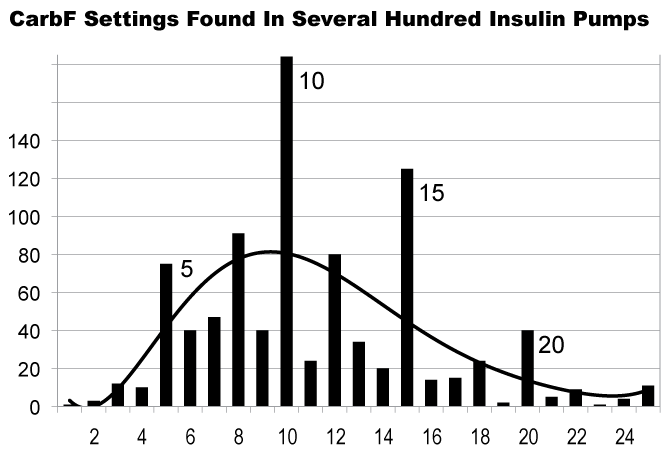The APP Study was conducted to see how people who have good control really use their pumps and to find what settings give the best glucose results. We analyzed anonymous data from several hundred Deltec Cozmo insulin pumps (Smiths Medical) that were consecutively downloaded during a large, routine software upgrade of all Cozmo pumps in 2007. The pumps were prescribed and used around the U.S. by a wide variety of clinicians and wearers. Insulin dosing was analyzed from a subset of 396 pumps where glucose readings were directly entered from an attached meter.
The basal/bolus balance and pump settings for one-third of the pumps (132 pumps) that had the lowest average glucose readings were determined. Formulas were then derived for optimal basal rates, carb factor (CarbF), and correction factor (CorrF) relative to individual total daily doses (TDD) of insulin.63, 69
| Group: | All 396 Pumps | Low Third | Mid Third | High Third |
|---|---|---|---|---|
| Avg. Meter BG | 184 mg / 10.2 mmol | 144 mg/dl (8.0) | 181 mg/dl (10.0) | 227mg/dl (12.6) |
| BG Tests/Day | 4.38 | 4.73 | 4.41 | 4.01 |
| TDD | 49.4 | 47.9 | 49.1 | 51.1 |
| Basal % | 47.6% | 47.6% | 47.2% | 47.8% |
| Carb Bolus U/d | 20.4 u | 20.9 u | 20.4 u | 19.8 u |
| Carb Bolus/Day | 4.14 | 4.07 | 4.20 | 4.14 |
| Carb Gram/Day | 189.9 | 185.2 | 196.3 | 187.9 |
| CarbF | 11.4 | 10.8 | 12.2 | 11.2 |
Key Findings of the APP Study
- The average glucose was 185 mg/dl (10.3 mmol/L) for all 396 pumps (120,445 glucose readings), equivalent to an estimated A1c of 8.1% or higher.
- Only 27.3% of pump wearers had average glucose below the ADA’s recommended goal of 7% or roughly 154 mg/dl (8.6 mmol/L) as average meter glucose. This indicates that most people currently on pumps need a higher TDD or more insulin.63
- People preferred easy to use CarbFs, like 5, 10, and 15, and CorrFs, like 50 and 100. The entry of precise factor settings in pumps would likely improve glucose outcomes.
- People used the BC for carb and correction bolus recommendations over 90% of the time.
- 64% of all boluses were given within 4.5 hours of each other, indicating that bolus insulin stacking is common.
- 92% of all pumpers entered grams of carb into their BC for at least 2 carb boluses a day.
- The group with the highest average glucose actually used more insulin than the group with the lowest average glucose. They did not differ in how many carbs they ate a day nor in the number of carb boluses given a day. Minor factors, such as a small reduction in the number of glucose tests and the use of higher CarbFs and CorrFs contributed only slightly to their higher readings. The major contributor to the hyperglycemia was a “relative” insulin deficiency. Their TDDs were simply too low.
- The lower glucose group (avg. BG 144 mg/dl or 8.0 mmol/L) had 2.74 documented glucose below 50 mg/dl (mmol/L) per month, compared to 1.00 in highest third (avg. BG 226 mg/dl or 12.7 mmol/L). Low glucose were more common with better control.
A convenient APP Pump Settings Tool can be found at www.opensourcediabetes.org.

